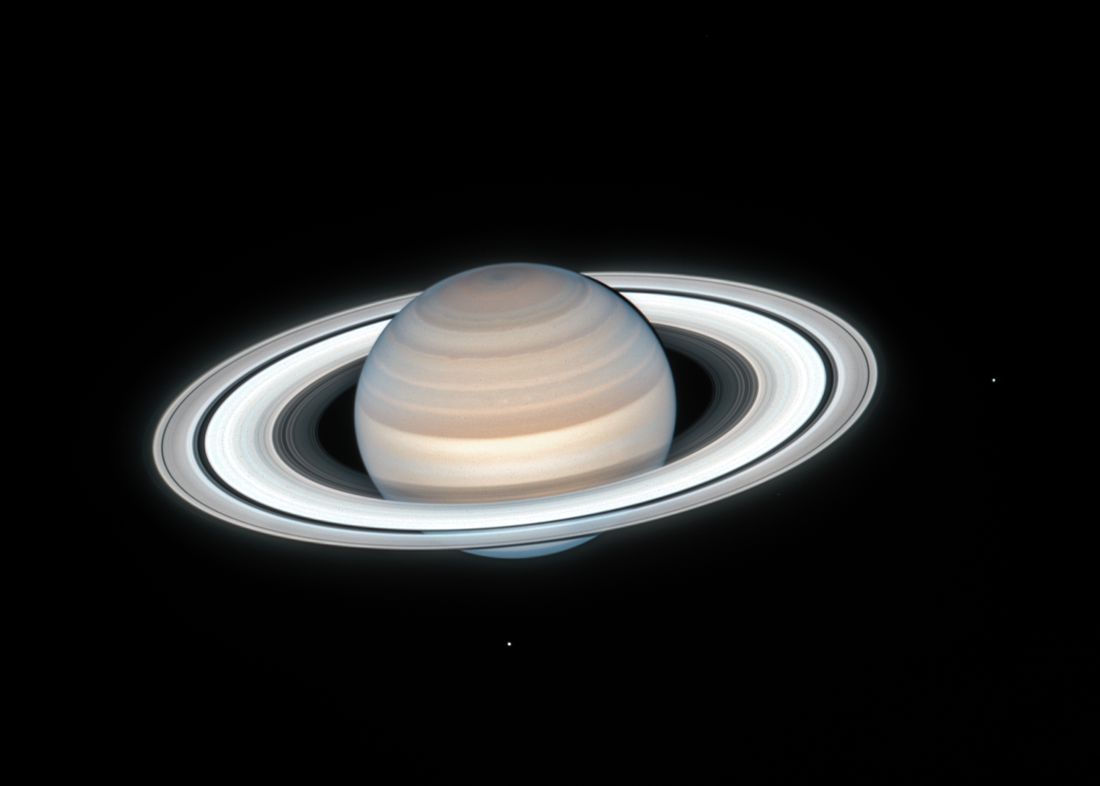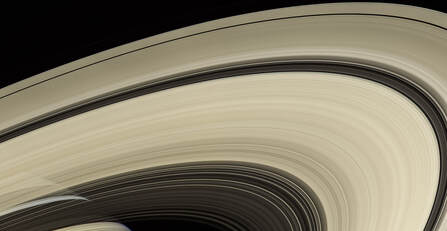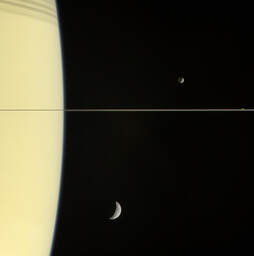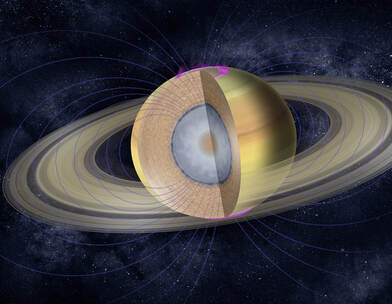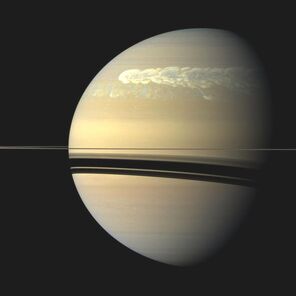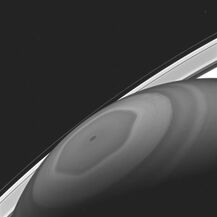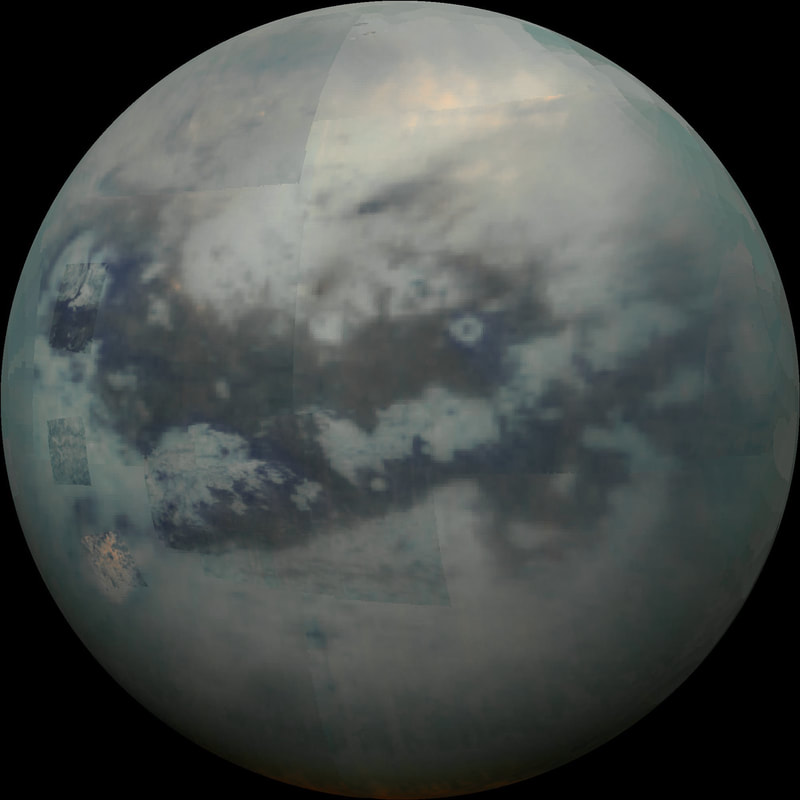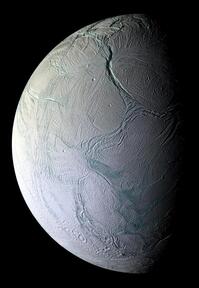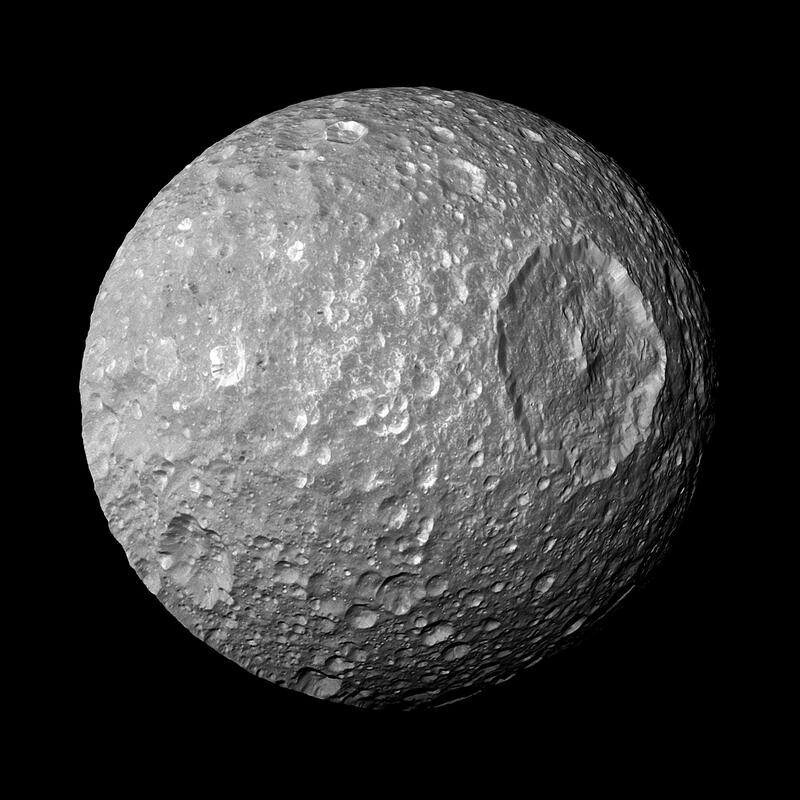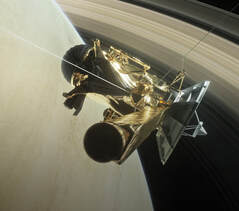SATURN
|
Formation Saturn is the sixth planet from the Sun and the second largest, after Jupiter. It formed about 4.5 billion years ago as gravity pulled gases swirling around the Sun into a spherical mass, about nine times the diameter of the Earth. Saturn is a “Gas Giant” comprised mostly of hydrogen and helium. Saturn’s density is lower than water, so in theory, it could float in a large enough pool. One year on Saturn equals 29.5 Earth years. Saturn has an axial tilt of about 27 degrees, and it therefore experiences seasons, like on Earth. Most small telescopes with a magnification of 25x or more will show the rings of Saturn. The angle of the rings as viewed from Earth changes, from a maximum of 27 degrees to zero degrees. So every 15 years, the rings when viewed from Earth, seem to disappear! |
|
The wide Cassini Division separates the outer A ring from the inner B ring. The planet peeks through the wispy C &D rings at the bottom left.
(NASA/JPL-Caltech/Space Science Institute) |
The origin of Saturn’s spectacular ring system is uncertain. It could have originated from the same primordial gases that formed Saturn, or from the remains of comets or moons that were torn apart by Saturn’s gravity. Alternatively, it may have originated from the outer layers of a large icy moon that were stripped off by Saturn’s gravity.
Comprised of mostly of small chunks of water ice with traces of dust and rock, the entire ring system has at least seven distinct bands. They are named alphabetically in the order of their discovery. Only the A, B, and C rings are easily visible from Earth-bound telescopes. The wide inner “B” ring is separated from the outer A ring by a distinct gap, called the “Cassini Division”. Each of the main rings is actually comprised of countless “ringlets”. These distinct ringlets are maintained by gravitational interactions with the major moons and by the orbits of tiny “moonlets” (shepherd moons) clearing a pathway within the major rings. The entire ring system extends at least 282,000 km. from the planet. |
|
The rings are very thin, especially compared to the size of the planet. They range in thickness from 10 meters to one kilometer, with an average thickness of only 20 meters. Individual particles range in size from microscopic to the size of a house, with much empty space between them. Their total mass is about one-half the mass of Earth’s Antarctic ice shelf, spread across an area 80 times greater the surface area of Earth. Recent data from the Cassini probe suggests that the rings may have formed within the last 100 million years, and may disappear within a few hundred million more.
|
|
Structure, Atmosphere and Magnetosphere Saturn is composed mostly of hydrogen (96.3%) and helium (3.25%). Travelling toward the centre, the pressure, temperature and density increases. At about 1000 km in, the pressure compresses the gas into liquid. Still further in, there is a thick layer of metallic hydrogen (hydrogen under such high pressure that it behaves like a metallic conductor of electricity). Saturn probably has a small rocky core of iron-nickel. Saturn has a magnetic field that is weaker at its equator than that of Earth. However, Saturn has nine times the diameter of Earth, and its equator is therefore much further away from the magnetic pole. Taking that difference into account, Saturn’s magnetism is 578 times stronger than Earth’s. It is a simple magnetic dipole (like a bar magnet), and it likely originates from electrical currents within the metallic hydrogen layer surrounding Saturn’s core. This magnetic field is effective in diverting solar wind particles and it produces aurorae. |
Saturn has a gaseous outer atmosphere, a liquified gas shell, then an inner metallic hydrogen shell with (probably) an iron-nickel core. (NASA/JPL-Caltech)
|
|
Through a telescope, the outer gaseous layers are relatively featureless, especially compared to the other gas giant, Jupiter. The upper cloud deck shows thin clouds of ammonia compounds and water ice. The “Great White Spot”, a seasonal storm system, has been observed once per Saturnian year (about 30 Earth years). Wind speeds on Saturn are among the highest in the Solar System, reaching 1800 km/h. Saturn spins on its axis once every 10 ½ hours. Because of Saturn’s size, this spin produces a rotational velocity at the equator of nearly 10 km/sec., resulting in a bulging at the equator of nearly 10%. Through a telescope, Saturn is noticeably wider at the equator.
|
|
Saturn’s north pole shows a strange, stable Polar Vortex in the shape of a hexagon (or stop sign). Each side of the hexagon is about 13,800 km. long- greater than the diameter of Earth. The vortex rotates once in 10 hours, 39 minutes, nearly matching the planet’s rotation. There is much speculation over the origin of this unique weather pattern, which is thought to be some type of standing wave. High speed cyclonic winds occur in latitudes below the vortex. The south pole shows a jet stream, but no evidence of a hexagonal vortex.
|
MOONS Saturn has at least 146 moons, as of June 2023. Only 13 of these have diameters greater than 50 km. and only seven are large enough to have formed into a ball. As technology advances, astronomers are able to detect smaller and smaller bodies orbiting Saturn. Unlike the major moons, early all of the new additions show large, highly inclined elliptical orbits. In addition, there are hundreds of small “moonlets” ranging in size from 40-500 meters that orbit within the ring systems.
|
Titan is the second largest moon in the Solar System. It is larger than the planet Mercury and almost as large as Mars. It is frequently described as “planet-like”, with a surface composed of rock and ice. Titan is the only moon in the Solar System with a significant atmosphere (nitrogen with methane clouds). It has wind and (methane) rain, resulting in rivers, lakes and seas of methane and ethane. Although rich in organic compounds, Titan's surface is likely too cold for life as we know it. However, its subsurface oceans might provide conditions that are suitable for microbial life.
|
Enceladus is about 500 km. in diameter. Its surface is complex, with smooth plains, heavily cratered areas, and tectonically molded features such as scarps, canyons and extensive cracks. The region of the South Pole shows hundreds of geysers venting plumes of water. Some of this water falls back to Enceladus and some forms Saturn’s "E" ring. There is good evidence of a subsurface water ocean more than 25 km. deep- more than six times the depth of Earth’s oceans. The exact mechanism that maintains the ocean in a liquid state is unknown. This ocean may underlie the entire frozen surface, and it may offer conditions to support microbial life.
|
Mimas is mostly comprised of water ice, with a small amount of rock. It is just under 400 km. in diameter. Mimas has a significant effect on Saturn’s rings through orbital resonances, which clear material from the Cassini Division (the large, distinctive gap between the "A" and "B" rings). Mimas has an enormous impact crater which spans 1/3 of its diameter. It makes Mimas resemble the “Death Star” of Star Wars fame, although this crater was unknown at the time the movie was made.
|
|
Missions Four interplanetary probes have visited Saturn. Pioneer 11 made the first journey in 1979, followed by Voyager 1 in 1980 and Voyager 2 in 1981. The Cassini-Huygens probe (commonly referred to as the Cassini probe) was a joint endeavour involving NASA, the European Space Agency (ESA) and the Italian Space Agency (ASI). This spectacularly successful mission launched in 1997 and lasted more than 19 years. The Huygens Lander successfully touched down on Titan, while the Cassini Orbiter (shown) completed flybys of many of Saturn’s moons and orbited Saturn 294 times before its planned destruction on September 15th, 2017.
|

